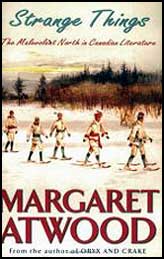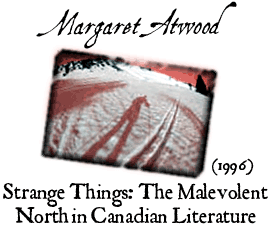

|

Strange Things: The Malevolent North in Canadian Literature
"In Strange Things, Atwood turns to the literary imagination of her native land, as she explores the mystique of the Canadian North and its impact on the work of writers such as Robertson Davies, Alice Munro, and Michael Ondaatje. Here readers will delight in Atwood's stimulating discussion of stories and storytelling, myths and their recreations, fiction and fact, and the weirdness of nature. In particular, she looks at three legends of the Canadian North. She describes the mystery of the disastrous Franklin expedition in which 135 people disappeared into the uncharted North. She examines the "Grey Owl syndrome" of white writers who turn primitive. And she looks at the terrifying myth of the cannibalistic, ice-hearted Wendigo—the gruesome Canadian snow monster who can spot the ice in your own heart and turn you into a Wendigo. Atwood shows how these myths have fired the literary imagination of her native Canada and have deeply colored essential components of its literature. And in a moving, final chapter, she discusses how a new generation of Canadian women writers have adapted the imagery of the North to explore contemporary themes of gender, the family, and sexuality. " —The Publisher.
|
Book Reviews
New York Times, 1996
University of Toronto Quarterly, 1996
|
 |
to Margaret Atwood's Non-fiction Works |
 |
to Margaret Atwood |
Luminarium Copyright ©1996-2007 Anniina Jokinen. All Rights Reserved.
Book cover images remain under the copyright of their respective copyright owners.
This page created on December 22, 2006 by Anniina Jokinen. Last updated January 3, 2007.
About this Website | Luminarium Privacy Statement.
Margaret Atwood has gone on to become not just
a major Canadian Writer, and a woman writer (whom some would call a Feminist Writer),
but an award-winning author of English literature. Her works include novels,
short stories, poetry, non-fiction, children's books, etc.
|




